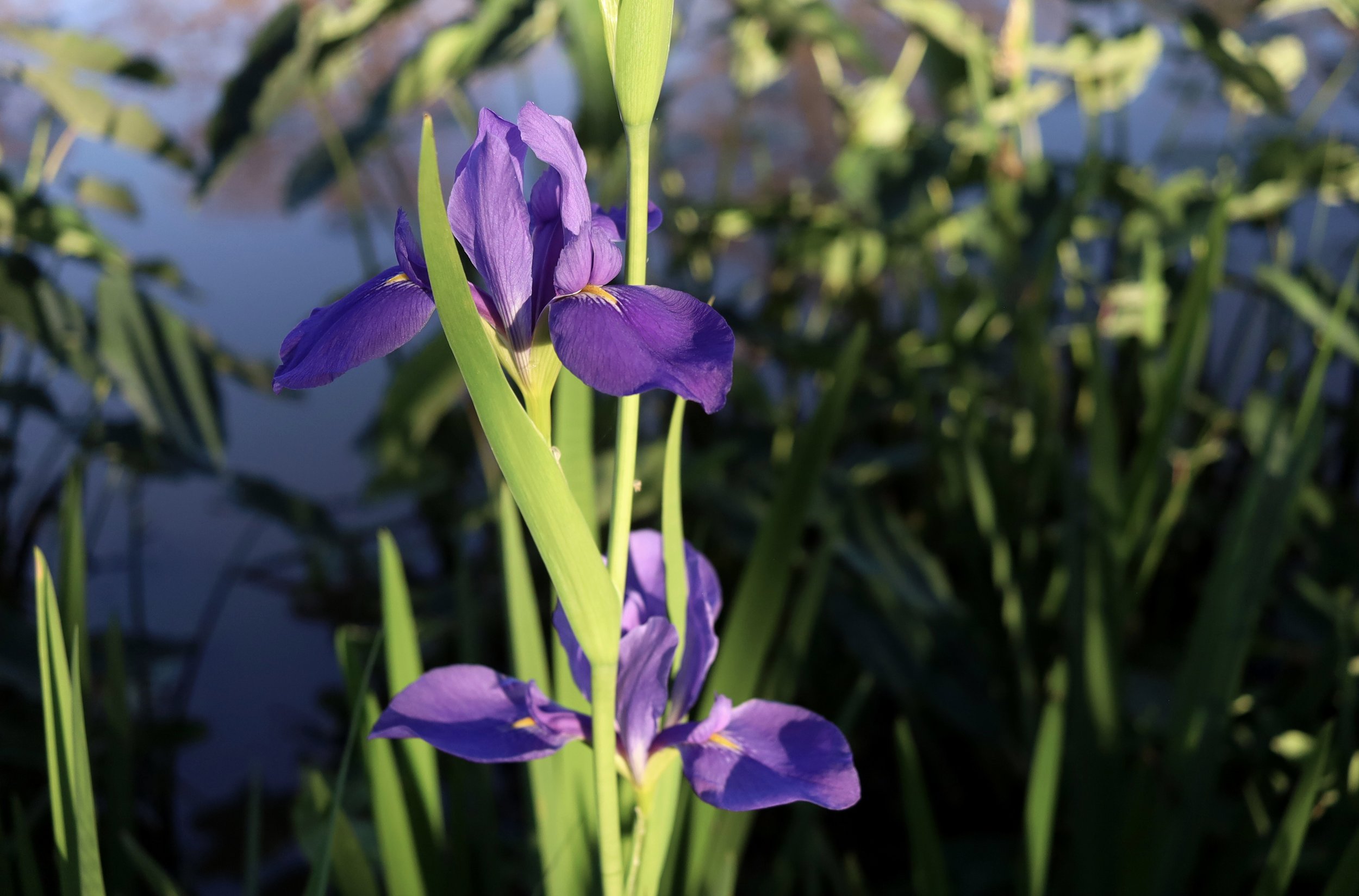Fragile, Wild and Sublime
Initiative to revive native population of Louisiana irises on Bayou Teche gathers momentum
Giant blue irises at Evangeline Oak Park
Johnny Appleseed, contrary to legend, didn’t roam the country at random spreading apple seeds wherever he went. He was much more methodical than that, scouting landscapes for suitable sites, developing relationships with farmers and gardeners, building nurseries for growing seedlings, and perhaps most importantly of all, retracing the routes he had already traveled, circling back to previous plantings every two or three years, decade after decade, until eventually he rooted the apple tree as much in the young nation’s imagination as in its fertile topsoil. If the Louisiana iris is the apple tree of Louisiana, then Gary Salathe, founder of the Louisiana Iris Conservation Initiative, you could say, is a kind of Johnny Appleseed but for irises.
Gary Salathe, founder of Louisiana Iris Conservation Initiative
On Saturday, November 25th, the St. Martinville Garden Club and the St. Martinville Chamber of Commerce invited Salathe to Evangeline Oak Park to plant Louisiana irises along the banks of the Bayou Teche. Standing beside a large red wagon filled with two hundred giant blue irises, Salathe, his long gray hair pulled back into a ponytail, described to the assembled volunteers the mission of his organization—to locate native Louisiana irises that are threatened with destruction and relocate them to areas where they can be appreciated by the public. Holding up a well-traveled poster display of Louisiana irises, he pointed to each of the five species in turn. Iris giganticaerulea, he informed the group, was the particular species they would be planting that morning. He tapped the image of the giant blue iris on the poster then gestured to the wagonload of Iris giganticaerulea behind him. The resident species of Louisiana iris at Evangeline Oak Park, would be getting reinforcements.
Iris giganticaerulea, commonly known as giant blue iris
You might mistakenly believe that these native plants can fend for themselves, that there will always be Louisiana irises in Louisiana. You might also mistakenly believe that the official state wildflower would be protected by some statute. Salathe stressed that there are no protections in place to guard against their destruction. Their habitat is disappearing at an alarming rate at the hands of builders and developers, and every parish in the state uses some form of herbicide spraying to manage roadside vegetation. The population of Louisiana irises dwindles every day. If we want them to thrive, it takes concerted effort. The Louisiana Iris Conservation Initiative, by partnering with groups around the state, and with the help of volunteers, has taken the lead, reintroducing tens of thousands of Louisiana irises into southern Louisiana landscapes.
After Salathe gave instructions on the proper planting of irises—the rhizomes should be planted no deeper than half an inch underground, and because they grow in the direction they’re pointing, they should be planted pointing toward the bayou—the volunteers dispersed along the western bank of Bayou Teche to fill in the blank spaces between the resident giant blue irises. Come March there should be a solid line of blue blooms for at least three hundred feet along the lotus-lined bank, all the way from the gazebo behind the Evangeline Oak to the TECHE Project’s kayak launch at the corner of Old Market Street as it elbows past the park.
Roots and rhizomes
And there are benefits to planting Louisiana irises beyond mere beautification. The native plant can be used in place of concrete rip-rap to stabilize the bayou’s shoreline. The hope is that the dramatic display of irises in the park might serve as an example for landowners to emulate. Moreover, the Evangeline Oak Park irises, like Johnny Appleseed’s nurseries, will also continue to serve as a living fund of irises for further propagation by the Garden Club.
Volunteers wrapped up the morning after planting three-quarters of the wagonload of irises. Salathe had another site in mind for the remaining irises—the TECHE Project’s kayak launch in Poche Bridge. In fact, he has been reintroducing giant blue irises at various locations up and down Bayou Teche, from Leonville to New Iberia. He has also been reinforcing the population of “Abbeville Red” Louisiana irises at Palmetto Island State Park for may years now, where the number of red irises growing in that park’s boardwalk swamp increasingly draws local sightseers and ecologically minded tourists.
Jude Theriot, volunteer
If you are imagining a vivid display of the red and blue wildflowers playing out across southern Louisiana each spring, that is the Louisiana Iris Conservation Initiative’s grand design. Salathe has partnered with Peter Patout and the city of New Iberia to make the inaugural Bayou Teche Native Louisiana Iris Festival a reality for the last weekend of March 2025. The educational festival is scheduled to take place in New Iberia and Palmetto Island State Park, ideally, at the peak of the Louisiana iris bloom. The timing of the two-week-long bloom, of course, varies somewhat from year to year, depending on several factors, most important of which is how warm the preceding winter is, but by the end of March, and certainly by early April, the blooms are sure to appear.
Giant blue irises at Evangeline Oak Park
Having tamed almost all of the wilderness out of our swamps, only now are we beginning to realize how precious those “wastelands” actually are, and today we can only achingly imagine the vast numbers of Louisiana irises that once decorated Bayou Teche. If Salathe has anything to say about it, we will soon no longer have to imagine. This place we call home, this green patch of earth we inhabit, is unlike any other, and a big part of what makes it unique are the fragile, wild and sublime native plants we live in this landscape alongside. You only have to see the deep blue petal of a Louisiana iris, perfectly sized and shaped for a visiting bumblebee to land on, and you will understand.







